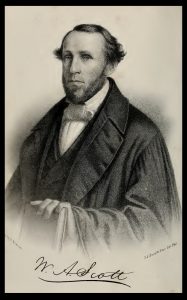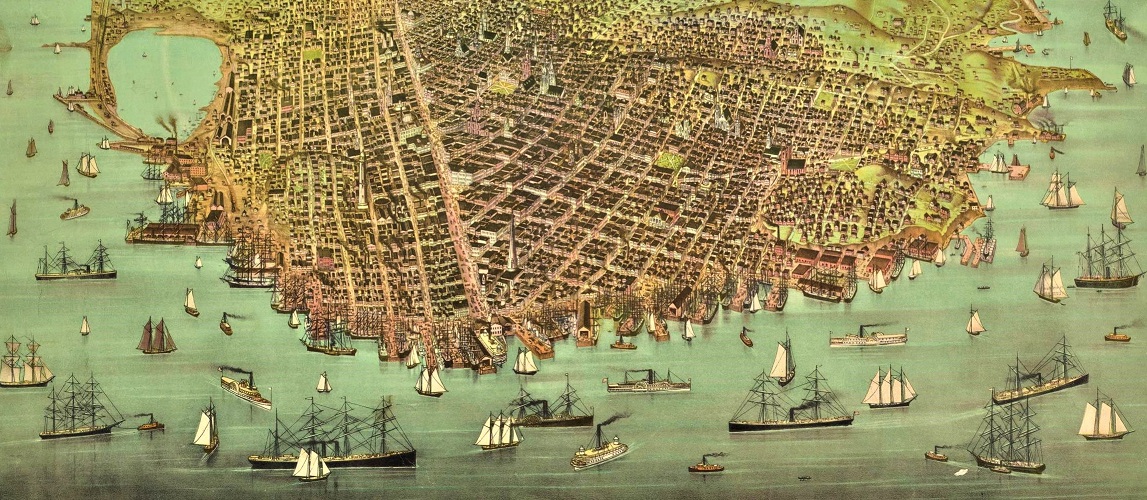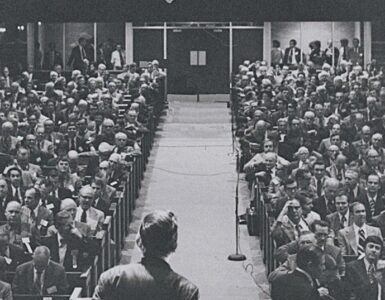 William Anderson was born to parents of Scotch-Irish descent named Eli and Martha (Anderson) Scott, January 30, 1813, at Rock Creek which is located south of Nashville in Bedford County, Tennessee. The Scotts found frontier Tennessee a challenge but then after moving to colder Illinois for two years they returned. The cantankerous mode of travel was a flatboat as they made a harrowing journey down the Mississippi River to settle on Big Creek near Memphis. Eli’s two older brothers, John and Joshua, had moved also providing mutual support as all the Scotts settled the land. The more prosperous brother, Joshua, hired a tutor to teach all the cousins in their own private schoolroom. William spent his youth on the family farm until at sixteen years of age he left to attend Cumberland College. The college had been established in Princeton, Kentucky by the Cumberland Presbyterian Church. A classmate of Scott, James A. Lyon, described him bluntly.
William Anderson was born to parents of Scotch-Irish descent named Eli and Martha (Anderson) Scott, January 30, 1813, at Rock Creek which is located south of Nashville in Bedford County, Tennessee. The Scotts found frontier Tennessee a challenge but then after moving to colder Illinois for two years they returned. The cantankerous mode of travel was a flatboat as they made a harrowing journey down the Mississippi River to settle on Big Creek near Memphis. Eli’s two older brothers, John and Joshua, had moved also providing mutual support as all the Scotts settled the land. The more prosperous brother, Joshua, hired a tutor to teach all the cousins in their own private schoolroom. William spent his youth on the family farm until at sixteen years of age he left to attend Cumberland College. The college had been established in Princeton, Kentucky by the Cumberland Presbyterian Church. A classmate of Scott, James A. Lyon, described him bluntly.
He is remembered as a great, big, fat, serious, sober, ruddy, smooth-faced, awkward boy (yes, boy), with now and then a gleaming from his eyes! And for his ambitious diligence in study, and for a voracious appetite for books. Every dollar that came into his hands was laid out in books, until he had not, any longer the wherewith to meet his current expenses for board and clothing. (Drury, 44)
The bibliomania afflicting Scott is reminiscent of that of Thomas Smyth. Scott graduated Cumberland College in 1833. He suffered financially for a number of years and his love of books may have contributed to the dearth of funds.
Scott moved to Princeton, New Jersey for seminary. He was on campus from February through the summer session of 1834. He had trouble adjusting to Princeton because it was larger and more formal than Cumberland College. Master linguist J. Addison Alexander took a special interest in Scott introducing him to the Syriac and Arabic languages. When Scott left Princeton he intended to return and complete the curriculum but limited funds, the travel distance, and a romantic interest that would lead to marriage ended his formal studies.
Scott returned to the South for ordination by the Cumberland Church’s Presbytery of Louisiana, May 17, 1835. His first call was to be a missionary in Louisiana and Arkansas. The hub of his field was the French-speaking community in Opelousas. Scott’s interest in languages led to fluency in French and uniquely qualified him to visit villages that included Red River, Bayou Bluff, and Alexandria. But he had a problem with the climate and diseases associated with the heat and humidity. The solution was a change of call while his romantic interest resulted in marriage to Ann Nicholson, January 19, 1836, with Rev. Robert A. Lapsley leading the service.
The Scotts left Louisiana in 1836 relocating to Winchester, Tennessee, where he became the principal of the Female Academy. Important for Scott, the move to Winchester included a theological transition because he left the Cumberland Church to join the Nashville Presbytery which would soon become an Old School presbytery with the division in 1837. Why did he change? According to Mrs. Scott there were two reasons—first, there was the practical reason that more opportunities were available with the larger Old School Presbyterian Church, and second, “He decided to change…saying that he could find no middle ground or resting place between Augustine and Arminius” (Drury, 69). Historically, it is an interesting statement because Arminianism arose in opposition to the teaching of Calvin, so one might expect instead of Augustine in the quote, the name Calvin. However, Scott’s doctrinal transition recognized the Reformation principle of ad fontes, “to the sources.” Calvin’s doctrine regarding salvation went back to fourth-century bishop Augustine of Hippo. The Battles edition of Calvin’s Institutes lists over 700 references to the works of Augustine, so Mrs. Scott’s summary of her husband’s reason for change to the Old School showed his belief that Arminius had gone in a new and unacceptable direction doctrinally and the early theology of Augustine from the era of ancient church ecumenical councils presented the teaching of Scripture truly.
As Scott finished ministry in the Winchester area the household moved northwest so he could principal the Nashville Female Academy, 1838-1840. During his administration the Academy’s enrollment was as high as 258 with as many as ten teachers constituting the faculty. In conjunction with educational duties he supplied the Little Harpeth Church and met outgoing United States President Andrew Jackson while supplying the Ephesus Church, currently the Hermitage Presbyterian Church on the Jackson estate. Jackson consulted Scott about some things, but the minister of First Church, Nashville, John Todd Edgar, provided the most spiritual direction for the aging president.
Scott moved to Alabama to serve a two-year call to First Church, Tuscaloosa, before beginning ministry with First Presbyterian Church in New Orleans. He was installed in Louisiana March 19, 1843. Scott was recommended for the call by the professors of Princeton Seminary. At the age of twenty nine, Scott succeeded well experienced and Princeton educated John Breckinridge, who supplied the church briefly before passing away at the age of forty four. When one thinks of a major southern city today Atlanta likely comes to mind, but this was not the case in Scott’s era. New Orleans was the great metropolis of the South with a population of 102,193 placing it third among the nation’s cities barely behind Baltimore (102,313) but well short of New York (312,710). If freight and passengers were to make cost-effective trips in or out of the heart of the nation, the Mississippi River accessed at New Orleans was the way to go. Scott’s health troubles during his Cumberland missions work returned in the hot and humid climate of New Orleans, but Scott found these years good for ministry and for his growing family. One event of his New Orleans years was adjudication of a case involving Scott and Senator Henry Clay of Kentucky who at the time was running for the presidency against James K. Polk. The gist of it is that Scott had accused Clay of playing cards on a riverboat on the Sabbath, but then later he denied making the accusation. He was tried for not telling the truth but was exonerated by Louisiana Presbytery.
When Scott left New Orleans in 1855 after a twelve-year tenure the church had grown from 341 to 607 members and had organized three new churches with core groups from First Church. The ministry in New Orleans was a positive transition for him because the English and French speaking residents were well suited to his work and the years solidified his commitment to Old School doctrine. The next time Scott would be in New Orleans was to attend the 1858 Old School General Assembly in First Church where he would be elected moderator.
The next call would be the most important of his life because he went to San Francisco just five years after gold had been discovered in 1848. San Francisco’s population was exploding with individuals from all over the world seeking gold while others were setting up venues for goods and services to be purchased with the gold harvested by prospectors. Added to this was a seaport linking the United States to the eastern states, Asia, and the rest of the world. The city was the key port of entry to the West as travelers sailed from the East to Panama, crossed the country, and then sailed on to San Francisco. Hundreds of abandoned ships littered the waters having been deserted by passengers and crews eagerly seeking gold. Living in California then was like living in a separate country with its government 2800 miles to the east across mountains, prairies, and arid terrain. The Sacramento Daily Union reported in 1856 that in the past six years over 1400 murders had been committed in San Francisco and many were calling for martial law. Adding to the chaos was a lack of sanitary services for all forms of waste. The San Francisco area had grown from a comparative handful of residents in a sleepy port town to more than 125,000 people in five years. This was the new mission field for William A. Scott, and it would be a difficult one but one he came to love.
The city needed an Old School Presbyterian Church, so Scott became the organizing pastor of Calvary Church in 1855. The more agreeable climate of San Francisco resulted in his having fewer health problems than in the past. Calvary grew as did both the Old and New Schools in California and with increasing church membership he began publishing in July 1859 The Pacific Expositor which he edited until he left California early in the Civil War. George Burrowes became the editor until the serial’s demise in 1862. For a time after Scott left California he travelled in Europe until he accepted a call in 1863 to the Forty-Second Street Presbyterian Church in New York. It is an interesting call for him to take because his sympathies were very much with the South. Scott returned to California in 1870 to pastor St. John’s Presbyterian Church; the Old and New Schools had reunited the previous year. With the booming growth of California in the post-war years as former soldiers moved west, there were increased opportunities for new churches. But there was a problem. The closest Presbyterian seminary was the Theological Seminary of the Northwest (McCormick) in Chicago, more than two-thousand miles away. October 3, 1871 the Synod of the Pacific at its meeting in First Church, Oakland, received a memorial signed by Scott, his associate at St. Johns, William Alexander, and five others. Just a month later the first board meeting was held with Scott elected the seminary’s first president and chair of Logic and Systematic Theology. Wicher described Scott’s importance:
The greatest of our founders, and the one to whom through the extended history of fifty years we owe the most, is unquestionably the Reverend William Anderson Scott, D.D., who was the first to think of any plan for the seminary, the first President of the Board of Directors, the first professor elected, the first President of the Faculty, the first trustee, [and] the first to occupy an endowed chair.(273)
The seminary began classes using two rooms of the City College until the trustees purchased a lot on Haight Street in 1877. Scott continued pastoral and educational ministry until his death, January 14, 1885, just short of his seventy-second birthday.
Returning to 1858 when Scott was moderator of the General Assembly, the commissioners convened in First Church, New Orleans, with the retiring moderator, Cortlandt Van Rensselaer, delivering his sermon from 2 Corinthians 13:11.
And if what was transitory came with glory, how much greater is the glory of that which lasts!
Scott was elected moderator from a slate of three. Dr. Robert J. Breckinridge’s motion to expunge titles prefacing the names of presbyters from the roll and in the minutes was adopted, but Breckinridge was still listed with his Dr. affixed in the minutes (possibly a slip of the pen after writing titles in the minutes for years). George Howe gave the annual address on behalf of the Presbyterian Historical Society. An overture to include Rouse’s or another version of the Psalms in the front of the hymnal was adopted so long as the Associate Reformed Synod in the South (ARPC) agreed. The Assembly was also working to have closer ties with the Reformed Synod of the South, the southern New School. The Presbyterians’ budget was relieved to have the commissioners’ fares home by steamboat and rail either reduced or eliminated. Breckinridge proposed the Old School prepare a commentary on the whole Bible, but what would have been a massive project was not adopted. The Assembly was concerned about a new edition of the Bible proposed by the American Bible Society. Breckinridge submitted a paper that was adopted stipulating that the only acceptable Bible for the Old School was an unedited King James Version. A communication from Dr. Monod of the Synod of the Free Church of France requesting the Old School to send a delegate for the 1859 meeting was agreed to with the requirement that the presbyter be already planning to go to France. It would have been an expensive exercise of church unity otherwise. Also discussed was how the centennial of the reunion of the Old and New Sides in 1758 should be remembered. Moderator Scott adjourned the assembly, Tuesday May 18, after 13 days including Sabbaths.
The Scotts had nine children including two girls and seven boys. Their names were Louisiana, Martha, Benjamin Francis, Calvin Knox, Chalmers, Ebenezer, Paul Eli, Robert Nicholson, and William Anderson, Jr. Ann Scott survived her husband only a few years dying, July 4, 1888. The San Francisco Seminary students described Ann as having been like a mother to them during Dr. Scott’s years of teaching and administration. He was honored with the D.D. by the University of Alabama, 1844, and the LL. D. by New York University, 1872. A few of his books are, The Christ of the Apostles Creed, The Voice of the Church against Arianism, Strauss and Renan (1867); The Giant Judge (i.e., Samson, 1858); The Bible and Politics (1859); Esther, The Hebrew-Persian Queen (1859); and Moses and the Pentateuch (1863). He also edited and wrote for ecclesiastical periodicals including the brief-run serial mentioned previously, The Pacific Expositor. The Log College Press website has a page for Scott that includes more bibliographical information as well as links to digital copies of his publications at “William Anderson Scott, Sr., (1813-1885).
Barry Waugh
Notes–The header is a bird’s eye view of San Francisco, circa 1878, by Currier and Ives, Library of Congress; the portrait is from vol. 2, 1861, The Pacific Expositor. The source for Scott’s life is Clifford M. Drury, William Anderson Scott: “No Ordinary Man,” Glendale: Arthur H. Clarke, 1967; the author travelled to sites for Scott, visited archives, and did extensive work for a complete narrative of his life, however, all the work is lost to further research because there are no footnotes, only a scanty bibliography noting three archive collections; but otherwise the book is nicely done and illustrated. A reconstructed Hermitage Church may currently be visited when touring the Andrew Jackson estate in Nashville. The quote by Edward A. Wicher is from The Presbyterian Church in California 1849-1927, New York: Frederick H. Hitchcock, The Grafton Press, 1927. Comments from Robert Coote of SFTS were helpful in composing this biography. Helpful was James Curry, History of the San Francisco Theological Seminary of the Presbyterian Church in the U.S.A. and Its Alumni Association, Vacaville: Reporter Publishing Company, 1907, and Robert R. Coote and John S. Hadsell, San Francisco Theological Seminary: The Shaping of a Western School of the Church, 1871-1998, San Anselmo: First Presbyterian Church, 1999. See also, Robert Lathan, History of the Associate Reformed synod of the South¸1882. The New Orleans population is for 1840 as on the United States Census website, “1940 Census Fast Facts.” I found “Vigilance Committees” in the Sacramento Daily Union, Vol. 11, No. 1614, 28 May 1856, page 2, in the California Digital Newspaper Collection, https://cdnc.ucr.edu/; Britannica Online provided the source. Information about Scott’s case with Henry Clay is summarized in, A History of the Presbyterian Church in Louisiana, by Penrose St. Amant, 1961, pages 82-84.





